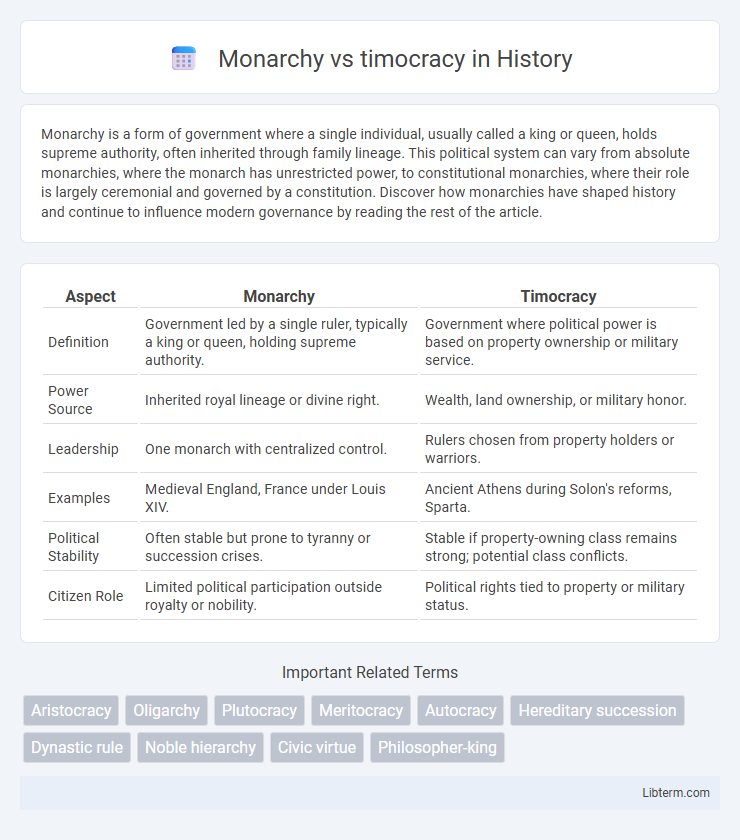Monarchy is a form of government where a single individual, usually called a king or queen, holds supreme authority, often inherited through family lineage. This political system can vary from absolute monarchies, where the monarch has unrestricted power, to constitutional monarchies, where their role is largely ceremonial and governed by a constitution. Discover how monarchies have shaped history and continue to influence modern governance by reading the rest of the article.
Table of Comparison
| Aspect | Monarchy | Timocracy |
|---|---|---|
| Definition | Government led by a single ruler, typically a king or queen, holding supreme authority. | Government where political power is based on property ownership or military service. |
| Power Source | Inherited royal lineage or divine right. | Wealth, land ownership, or military honor. |
| Leadership | One monarch with centralized control. | Rulers chosen from property holders or warriors. |
| Examples | Medieval England, France under Louis XIV. | Ancient Athens during Solon's reforms, Sparta. |
| Political Stability | Often stable but prone to tyranny or succession crises. | Stable if property-owning class remains strong; potential class conflicts. |
| Citizen Role | Limited political participation outside royalty or nobility. | Political rights tied to property or military status. |
Understanding Monarchy: Definition and Origins
Monarchy is a form of government where a single individual, often hereditary, holds supreme authority, traced back to ancient civilizations such as Mesopotamia and Egypt. This system centralizes power in a monarch who rules for life or until abdication, legitimized by tradition or divine right. Understanding monarchy involves examining its origins as the earliest organized political structure, influencing many modern governance institutions.
What is Timocracy? Historical Context and Meaning
Timocracy is a form of government where political power is tied to property ownership or military service, emphasizing honor and landholding as criteria for leadership. Originating in ancient Greek philosophy, notably in Plato's Republic, timocracy was seen as an intermediate regime between aristocracy and democracy. Unlike monarchy, which centralizes authority in a single ruler, timocracy distributes political influence among landowners or warriors who uphold societal virtue through wealth or service.
Key Philosophical Foundations: Monarchy vs Timocracy
Monarchy is grounded in the philosophical notion of centralized authority vested in a single ruler, often justified by divine right or natural order, emphasizing stability and unified governance. Timocracy, as outlined by Plato, prioritizes the rule of property owners or warriors, linking political power to honor, military virtue, and wealth rather than hereditary succession. The key philosophical distinction lies in monarchy's concentration of power in sovereign leadership versus timocracy's distribution of power among a class defined by military merit and property ownership.
Power Structures: Monarchs vs Rulers by Merit
Monarchy centralizes power in a single hereditary ruler, often justified by divine right or lineage, creating a stable but sometimes rigid power structure. Timocracy allocates power based on merit, particularly wealth or property ownership, emphasizing accountability and competence in governance. Monarchs wield authority through tradition and inheritance, whereas timocratic rulers gain legitimacy by demonstrable qualifications and civic virtue.
The Role of Wealth and Lineage in Governance
Monarchy centers governance on hereditary lineage, where power is inherited through family bloodlines, emphasizing noble birthright over wealth. Timocracy bases political authority on property ownership, granting influence proportionate to an individual's wealth and economic contribution. The contrasting systems highlight lineage as the primary criterion in monarchy, while timocracy prioritizes material wealth as a measure of legitimacy and governance participation.
Political Stability: Comparing Monarchy and Timocracy
Monarchy often provides long-term political stability through centralized power and clear succession rules, minimizing internal conflicts. Timocracy, characterized by rule based on property ownership or military achievement, can lead to fluctuating power dynamics and potential instability due to competing elite interests. Historical examples demonstrate monarchies maintaining consistent governance structures, while timocratic systems frequently experience shifts in authority and social unrest.
Citizen Participation and Rights Under Each System
Monarchy centralizes authority in a single ruler, often resulting in limited citizen participation and restricted political rights, as power is inherited rather than elected. Timocracy promotes political involvement based on property ownership or military service, granting citizens with substantial wealth or status more influence and rights in governance. Both systems contrast sharply with modern democratic ideals where broad citizen participation and equal rights are foundational.
Historical Examples: Monarchical vs Timocratic States
Historical monarchies such as the British Empire and the Kingdom of France exemplify centralized rule by a single sovereign, often legitimized by hereditary succession and divine right. Timocratic states like ancient Athens during its early classical period prioritized property ownership and military service as qualifications for political participation, reflecting a system valuing honor and duty over hereditary privilege. Comparative studies reveal that monarchies often centralized power and maintained stability through dynastic continuity, while timocracies fostered a more participatory form of governance rooted in civic responsibility and military merit.
Advantages and Disadvantages of Monarchy and Timocracy
Monarchy offers centralized authority that can lead to stable and consistent governance, benefiting from clear succession and long-term planning; however, it risks autocratic rule and lack of accountability, potentially resulting in oppression or inefficiency. Timocracy, characterized by political power tied to property ownership or wealth, promotes civic virtue and merit-based leadership, but often excludes lower socioeconomic classes and can foster inequality or oligarchic tendencies. Both systems reflect trade-offs between stability, inclusivity, and individual rights, influencing their suitability depending on societal values and historical context.
Future Relevance: Monarchy or Timocracy in Modern Governance
Monarchy retains future relevance in modern governance primarily through constitutional monarchies that balance ceremonial authority with democratic institutions, ensuring political stability and cultural continuity. Timocracy, characterized by rule based on property ownership or military merit, faces challenges in contemporary societies valuing egalitarian principles and inclusive governance but may influence certain meritocratic or technocratic systems. Emerging hybrid models integrating hereditary leadership with merit-based advisory councils highlight ongoing experimentation in adapting traditional monarchic elements to future governance needs.
Monarchy Infographic

 libterm.com
libterm.com